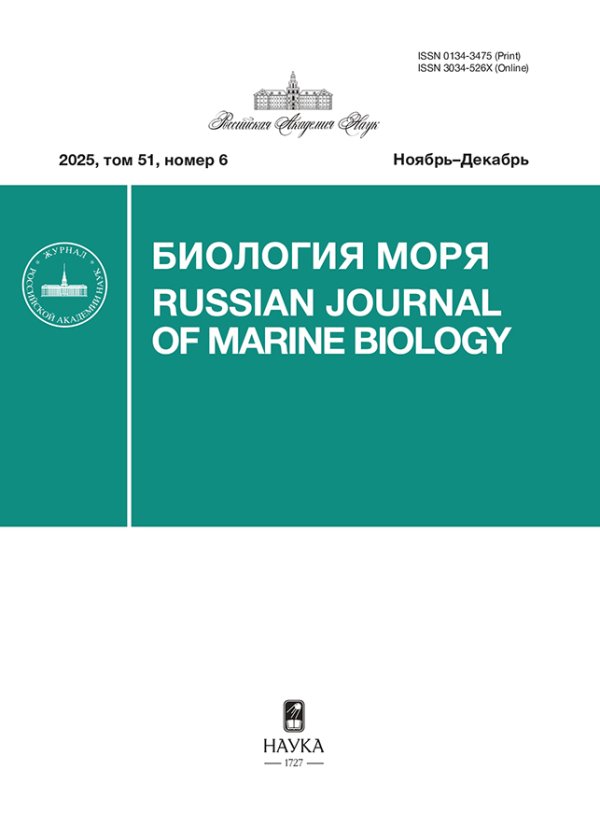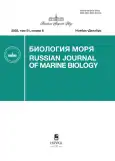Том 51, № 6 (2025)
- Год: 2025
- Выпуск опубликован: 15.11.2025
- Статей: 7
- URL: https://journals.rcsi.science/0134-3475/issue/view/24763
ОБЗОР
ВЛИЯНИЕ ТЯЖЕЛЫХ МЕТАЛЛОВ НА ДИНОФЛАГЕЛЛЯТ
Аннотация
Среди разнообразия морского фитопланктона большой интерес представляют динофлагелляты – группа протистов, доминирующая в экосистемах океана и вызывающая вредоносное цветение водорослей (ВЦВ). Обобщена информация о влиянии загрязняющих веществ (кадмия, никеля, меди, ртути, свинца, цинка и др.) на динамику численности, морфологию, биохимические показатели и фотосинтетическую активность этой группы микроводорослей. Рассматриваются устойчивость динофитовых к тяжелым металлам (ТМ), а также механизмы воздействия данных веществ на микроводоросли, в частности накопление и токсичность, окислительный стресс, ингибирование ферментативной активности, подавление фотосинтетических процессов, изменение морфологии клеток. Обсуждается действие ТМ на экосистемные процессы, включая усиление ВЦВ, вызванные динофлагеллятами, продуцирующими опасные токсины.
 301-318
301-318


ОРИГИНАЛЬНЫЕ СТАТЬИ
ТАФОЦЕНОЗЫ МИКРОФОССИЛИЙ В ПОВЕРХНОСТНЫХ ОСАДКАХ ВОСТОЧНО-СИБИРСКОГО МОРЯ И КОТЛОВИНЫ ПОДВОДНИКОВ (СЕВЕРНЫЙ ЛЕДОВИТЫЙ ОКЕАН) И ИХ ЗНАЧЕНИЕ ДЛЯ ПАЛЕОРЕКОНСТРУКЦИЙ
Аннотация
 319-343
319-343


ПЕРВЫЙ БАРКОДИНГОВЫЙ АНАЛИЗ СИМБИОТИЧЕСКИХ НЕМЕРТИН РОДА MALACOBDELLA BLAINVILLE, 1827 (НОРLONEMERTEA: MONOSTILIFERA) ИЗ ДАЛЬНЕВОСТОЧНЫХ МОРЕЙ РОССИИ
Аннотация
На основе анализа фрагментов гена, кодирующего субъединицу I цитохромоксидазы (COI), подтверждено обитание Malacobdella grossa в зал. Петра Великого (Японское море). Сиквенсы четырех особей из Японского моря принадлежат к одному гаплотипу и отличаются от сиквенсов особей из Белого и Северного морей 3–5 заменами. Это первый вид голлонемертин, для которого на генетическом уровне подтвержден трансарктический ареал. Изученные особи Malacobdella japonica из зал. Анива (о. Сахалин) принадлежат к тому же гаплотипу, что и особи из зал. Аккеси и провинции Ибараки (Япония).
 344-350
344-350


СТРАТЕГИЯ ВЫЖИВАНИЯ ДИАТОМОВОЙ ВОДОРОСЛИ PSEUDO-NITZSCHIA PUNGENS (GRUNOW EX CLEVE) HASLE, 1993 В УСЛОВИЯХ ДЛИТЕЛЬНОЙ ТЕМНОТЫ
Аннотация
Исследована физиологическая реакция морской диатомовой водоросли Pseudo-nitzschia pungens на темновую экспозицию в течение 45 и 90 сут и последующую акклимацию при повторном освещении. Установлено, что водоросль остается метаболически активной между 0 и 45 сут темновой экспозиции. Этот этап характеризуется стабилизацией плотности культуры, активацией дыхательного метаболизма и синтетических процессов, а также низкой скоростью потребления внутриклеточных углерода (С) и азота (N). Между 45 и 90 сут темновой экспозиции клетки P. pungens переходят в состояние покоя, которое сопровождается прекращением клеточных делений, подавлением синтетических процессов, а также консервацией светособирающего комплекса и почти полным подавлением фотосинтеза. Жизнеспособность клеток обеспечивается сохранением высокой дыхательной активности и поддержанием высокого уровня внутриклеточных резервов С. Показано, что поэтапная реорганизация структуры и функции фотосинтетического аппарата P. pungens в условиях длительной темноты способствует сохранению фотосинтетической способности клеток и последующему восстановлению плотности популяции P. pungens при переносе на свет. Продолжительность периода восстановления численности водорослей, а также регенерации структуры их светособирающего комплекса определяются длительностью пребывания в темноте.
 351-364
351-364


ОПРЕДЕЛЕНИЕ МИНИМАЛЬНОГО КОЛИЧЕСТВА МИКРОСАТЕЛЛИТНЫХ ЛОКУСОВ ДЛЯ ПРЕДВАРИТЕЛЬНОЙ ОЦЕНКИ ПОПУЛЯЦИОННО-ГЕНЕТИЧЕСКОЙ СТРУКТУРЫ ДАЛЬНЕВОСТОЧНОГО ТРЕПАНГА APOSTICHOPUS JAPONICUS (SELENKA, 1867) (ECHINODERMATA: HOLOTHUROIDEA)
Аннотация
 365-374
365-374


ТРОФИЧЕСКАЯ ХАРАКТЕРИСТИКА ДВУСТВОРЧАТЫХ МОЛЛЮСКОВ (BIVALVIA) НА МЕЛКОВОДНОМ ШЕЛЬФЕ МОРЯ ЛАПТЕВЫХ
Аннотация
 375-390
375-390


Авторский указатель за 2025 г.
Авторский указатель. Том 51, 2025 г.
 391-396
391-396












